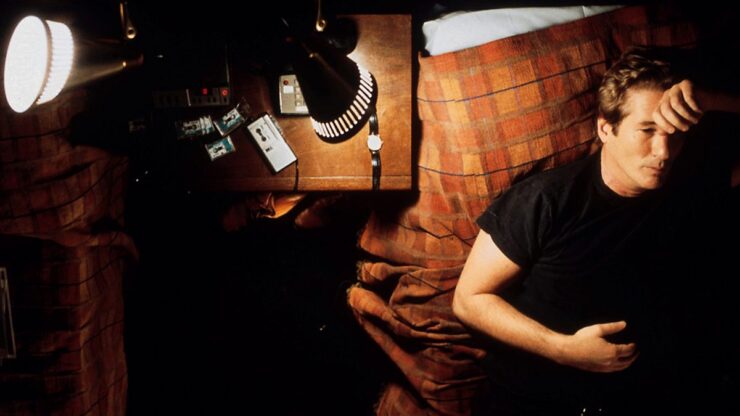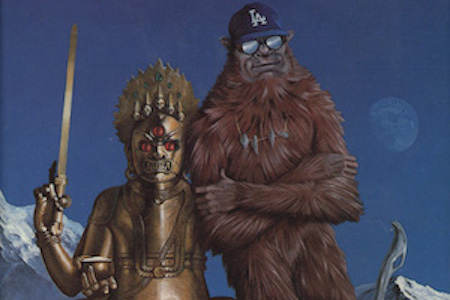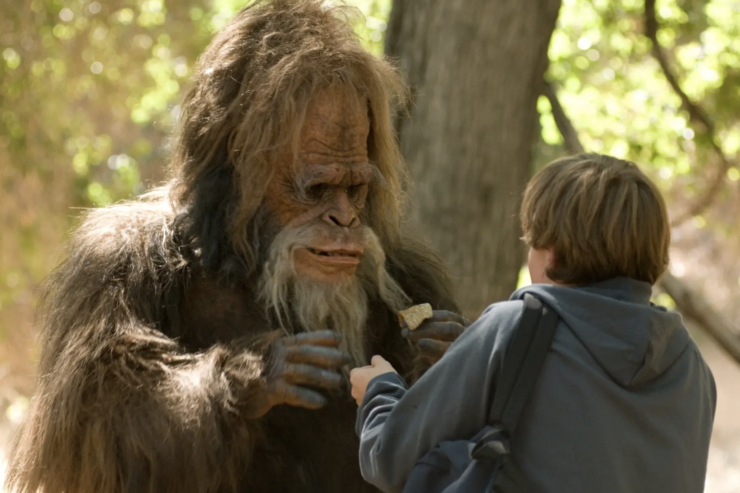Mark Pellington’s 2002 film, based on John Keel’s 1975 book, was my gateway drug to the weirdness that is the Mothman. I’ll tackle the book next week. For now, let’s just sit back and watch the horror ever so slowly unfold, as Richard Gere plays Washington Post ace reporter John Klein.
John has a perfect career as a political reporter. His perfect wife, Mary (Debra Messing), joins him on a cold winter evening to tour a gorgeous house-for-sale. Of course they offer on it, and the offer is instantly accepted (this is, after all, fantasy)—but the ominous soundtrack and the shadowy visuals warn us not to get complacent.
Sure enough, on the way home from the house, Mary sees a monstrous shadow with red eyes, and crashes the car. She wakes, eventually, in the hospital, with John hovering and emoting. She’s been diagnosed with a brain tumor, which presumably caused the hallucination. It’s a very rare form, of course, a glioblastoma, and of course it’s inoperable and naturally it’s terminal. Pellington has fridged the perfect wife.
After she rather quickly dies (offstage, no less), a helpful nurse tells John what Mary did while John was, presumably, either working or hanging morosely with his buddy. She kept drawing “angels”—but they’re not the pretty, happy kind. They’re dark and heavily scrawly and terrifying. The clearest of them looks like a kind of alien moth.
Fast-forward two years to John doing his reporter thing and ducking his friend’s attempts to hook him up with a nice woman. John has a gig in Richmond, interviewing the governor, which he’s using as an excuse for avoiding the latest would-be Mrs. Klein. The interview gets postponed to later the next day, but he decides to drive to Richmond overnight.
Somehow, mysteriously, his car ends up breaking down on a dark road very far indeed from Richmond, though it’s some little time before he discovers this. All he knows is that he’s stranded and he needs to find a convenient phone to call for help. In 2002, cell phones have not yet become ubiquitous. People have to actually trek to the nearest landline, which in this case results in John being cornered in a retro pink-tiled shower by wild-eyed, gun-toting Gordon.
Gordon (Will Patton), who rather resembles later-season Jim Hopper (David Harbour) in Stranger Things, swears that this is the third night running that John has knocked at his door in the wee tiny hours and asked to use his phone. Local cop Connie (Laura Linney) saves the day, or rather the night, and extricates John from the shower. She gives him a ride to a motel, where he can stay until his car is retrieved and checked out by a mechanic.
John has, somehow, traveled four hundred miles in ninety minutes, at normal highway speeds, to the town of Point Pleasant on the border of West Virginia and Ohio. Most of the rest of the film unfolds here, as John learns that there’s nothing wrong with his car, but a great deal wrong with people in Point Pleasant. An ever-increasing number of them have been seeing the same creature that Mary drew so obsessively in her deathbed journal.
John has no choice but to stay in Point Pleasant and try to solve the mystery. He was guided here, he’s convinced, and it’s tied in somehow with his late wife. How can he walk away from that?
The plot gets thicker the longer John stays in Point Pleasant. The creature he names the Mothman appears to be a harbinger of disaster. He’s led to this conclusion by Gordon, who becomes a friend, and by weird and unsettling communications from a being called Indrid Cold, as well as by elusive Mothman expert Alexander Leek (Alan Bates). There’s even a cameo by a person who looks and talks exactly like Mary.
The Mothman remains a mystery, but as far as John can determine, he (or it) appears before major tragedies. He’s seen all over the world. Leek doesn’t believe he causes the tragedies; he’s more of an observer. He’s not human; nor is Indrid Cold, who may or may not be either the Mothman himself or his spokesperson. It’s all very murky, like the soundtrack and the cinematography.
In the end, after a wrong turn or two, John discovers that he’s been brought to Point Pleasant to witness the collapse of the Silver Bridge. The actual event occurred on December 15, 1967. Forty-six people died—Pellington claims thirty-six. Leek urges John to stay away from the doomed town, but naturally he can’t do that. After he’s left for home, Connie invites him to her family’s Christmas Eve party (another alteration of the historical record), and he drives all the way from Georgetown to attend—arriving just in time for the collapse of the bridge and his leap into the river to rescue Connie, who has dreamed that she’s the thirty-seventh victim. The film’s brief epilogue claims that no one ever found out what happened to cause the bridge to fail; that’s not in fact true. But it makes for nice movie drama. The Mothman, supposedly, was never seen again in Point Pleasant.
That hasn’t prevented the town from turning itself into Mothman Central. I’ll talk more about that in the next installment or two. After all, what’s a poor town to do when it’s blessed or cursed with a famous cryptid, but make the most of its notoriety?
There’s a lot more to the Mothman than we see in the film. Mostly here, it’s about John. His lost love. His determination to find out what really killed her—surely it’s not a simple brain tumor; surely she wasn’t just hallucinating. His new friends in Point Pleasant, and his heroic rescue of the helpless Connie.
He loses the woman he loves, but he saves a woman he cares about. He’s never in any real danger himself, and he’s mostly led around by others’ expertise: Mary’s visions, the voices in Gordon’s head, Connie’s reports from the law-enforcement front, Indrid Cold’s eerie communications, and Leek’s superior knowledge and dire warnings. The Mothman remains a shadowy being, never clearly seen and never properly understood.
As far as we can tell, John’s quest ends when the bridge falls. Maybe he ends up with Connie. Maybe he goes back to his job at the WaPo. Or maybe, like John Keel, he spins off into a career as a parapsychologist and pseudoscientist, tracking the weird across the world.
Judith Tarr is a lifelong horse person. She supports her habit by writing works of fantasy and science fiction as well as historical novels, many of which have been published as ebooks. She’s written a primer for writers who want to write about horses: Writing Horses: The Fine Art of Getting It Right. She lives near Tucson, Arizona with a herd of Lipizzans, a clowder of cats, and a blue-eyed dog.














